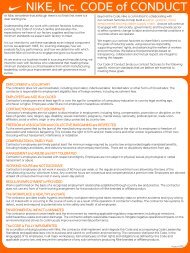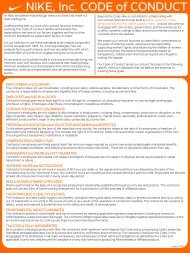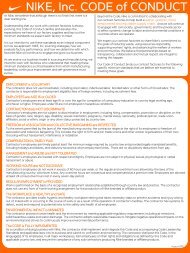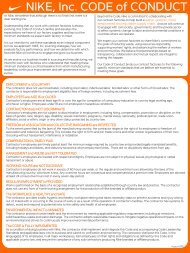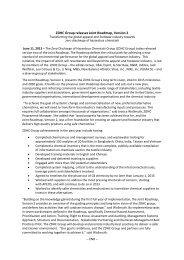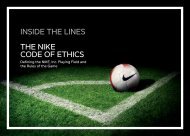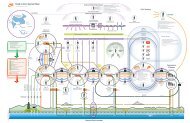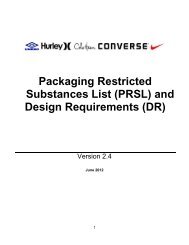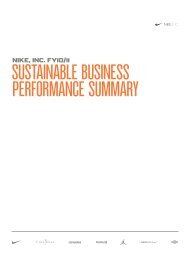COC CLS - Healthy Safety Environment - NIKE, Inc. - The Journey
COC CLS - Healthy Safety Environment - NIKE, Inc. - The Journey
COC CLS - Healthy Safety Environment - NIKE, Inc. - The Journey
You also want an ePaper? Increase the reach of your titles
YUMPU automatically turns print PDFs into web optimized ePapers that Google loves.
HEAT STRESS MANAGEMENT<br />
• Take breaks in the shaded area and allow time to recover from the heat.<br />
• Avoid or limit the use of alcohol and caffeine during times of extreme heat because both<br />
dehydrate the body.<br />
• Inform the supervisor if he/she, or another employee, begin feeling dizzy, nauseous, weak,<br />
or fatigued and to rest in the shade for a time sufficient to recover. In addition to seek<br />
medical attention if the problem persists.<br />
• Wear appropriate clothing, sunscreen, and hats.<br />
• Pay attention to coworkers and keep an eye out for symptoms of heat stress, reporting<br />
the symptoms to the employer directly or through the supervisor. “Buddy” systems can<br />
be useful to ensure that workers watch out for each other.<br />
• Procedures for responding to symptoms of possible heat illness, including how<br />
emergency medical services will be provided if necessary.<br />
• How to contact emergency services, and if necessary, how to transport employees to a<br />
place where they can be reached by emergency medical services. A nearby hospital<br />
or emergency care facility should be clearly identified in worksite postings.<br />
• Procedures for providing clear and precise directions to the worksite to emergency<br />
medical services. Employees should have access to road maps with field locations<br />
clearly marked so that directions can be provided to emergency responders.<br />
• Have refresher trainings or “tailgate meetings” where brief safety reminders about heat<br />
illness. <strong>The</strong>se should be conducted frequently, especially during high temperatures.<br />
Supervisory Employees should also be trained on:<br />
• <strong>The</strong> supervisor’s responsibilities in ensuring that the heat stress regulations are followed.<br />
• What the supervisor must do when an employee exhibits symptoms of possible heat<br />
illness.<br />
• How emergency medical services will be provided should they become necessary.<br />
• How emergency medical service providers will be contacted.<br />
• How employees will be transported to a point where they can be reached by an<br />
emergency medical service provider if necessary.<br />
• How, in the event of an emergency, clear and precise directions to the worksite will be<br />
provided as needed to the emergency responder.<br />
3. DOCUMENTATION—<br />
Training Records: Each facility must maintain training records for a minimum of 3 years.<br />
<strong>Inc</strong>ident Records: Each facility must maintain incident records for a minimum of 5 years.<br />
<strong>Safety</strong> <strong>CLS</strong> – Page 3<br />
04.14.10



